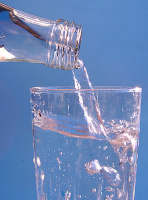drinking water
Drinking water is fresh water, an essential component of human food. Its source is rainwater, underground water and, to a certain extent, river and lake water. Water is also contained (in a certain percentage) in the human body.
For the purposes of the drinking regime, water must be used in Slovakia that complies with the conditions of Regulation of the Government of the Slovak Republic no. 354/2006 Coll., establishing requirements for water intended for human consumption and quality control of water intended for human consumption.
Control of water in public water supply systems is carried out by operators of water supply systems and public health authorities.
More than two billion inhabitants do not have access to drinking water at home. The largest number of people without access to drinking water are in India, Ethiopia, Nigeria and China
Definitions related to the indicator:
Drinking water is water in its original state or after treatment intended for drinking, cooking, food preparation or other domestic purposes, regardless of its origin and whether it was delivered from a distribution network, a tank or as water packaged in consumer packaging and water used in food enterprises in the production, processing, preservation or sale of products or substances intended for human consumption.
Drinking water is safe for health if:
a) does not contain any microorganisms, parasites or substances that in certain quantities or concentrations pose a risk of endangering human health through acute, chronic or late exposure, and whose properties perceptible by the senses do not prevent its consumption or use, and
b) meets the limits of drinking water quality indicators according to SR Government Regulation No. 354/2006 Coll. as amended by SR Government Regulation No. 496/2010 Coll.
A public water supply is a set of objects and facilities serving a public need, enabling mass supply of water to the population and other customers.
The supply of water to the population from public water supply systems is expressed by the number of the population or the percentage of the population connected to the distribution network of public water supply systems
Specific household water demand the amount of water supplied to households (i.e. water billed to households) per person per unit of time.
An indicator value is a value of a drinking water quality indicator of a non-specific or group nature used to assess the need for more detailed drinking water quality tests.
The highest limit value is the value of a health-significant indicator of the quality of drinking water, exceeding which excludes the use of water as drinking water.
The limit value is the value of the indicator of the quality of drinking water, when it is exceeded, the drinking water loses its satisfactory quality in the indicator whose value was exceeded.

